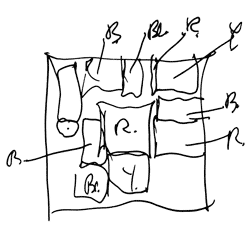|
ROBERT SLUTZKY: AN APPRECIATION
 |  | |  Sketch for Source Hollandays, 1958/74 Sketch for Source Hollandays, 1958/74 |  |
Robert Slutzky was an artist, theorist, and teacher, a graduate of The Cooper Union and Yale, and a former Professor in Architecture and Art at The Cooper Union and the University of Pennsylvania.
His painting, in the tradition of Mondrian, van Doesburg, and his teacher Josef Albers, explored the dimensions of color and abstract form in relation to the picture plane and its three-dimensional implications. It was these implications that made his work and theoretical investigations of serious interest and importance to architects. Through and by means of painting, he insistently registered the sometimes ambiguous, but always present, spatial relations between the painted plane and the architectonic volume, and his teaching at The Cooper Union between 1968 and 1990 formed a generation of students sensitive to color, light, and space. His dedication to teaching was legendary and his trenchant but reasoned criticism was a stimulus to intensive study. Slutzky’s work was always envisaged in the collaborative mode that informed his teaching and writing, ranging from his visual “conversation” with John Hejduk on the “Diamond in Painting and Architecture” of 1967 to his construction of the three-dimensional studies in color and space for “cHUbE/cHrOME” with the young Swiss architects Bruce Dunning and Peter Versteegh in the late 1980s.
Perhaps he is best known today as a co-author with Colin Rowe of two essays on the theme of “transparency,” written in the mid–1950s but not published until 1963 and 1971. While these essays have generally been seen more as an integral part of Rowe’s oeuvre, close inspection of Rowe’s previous writings indicates the strength of Slutzky’s influence; the two collaborated in teaching and writing at the University of Texas, Austin, between 1954 and 1956, together with the architects John Hejduk and Bernhard Hoesli. In this context, the “transparency” essays form a seamless continuity with Slutzky’s painting, where the painted surface is viewed as transparent to space, so to speak, acting less as a substitute for a “window” (the commonplace of perspectival representation) than a series of superimposed layers, implied or revealed, that both project and introject a spatial construction. In this sense, while painting may always be carefully separated from architecture, in its formal aims and social intentions, the two arts have, in Slutzky’s work, developed an endless reciprocity, whereby painting is taken, as Le Corbusier assumed but hardly theorized, as a laboratory for architecture, or better, as architecture in itself.
 |  | |  Source Hollandays, 1958/74 Source Hollandays, 1958/74 |  |
Transparency, of course, was a fetish of modernism, attaining the status of what Colin Rowe termed a “sacred cow” for architects like Walter Gropius and Mies van der Rohe. From the Expressionist “glass architecture” of Bruno Taut and Paul Scheerbart and Mies’s early projects for glass skyscrapers, to Gropius’s Fagus Werke and Bauhaus (the corner of which was in turn fetishized by Sigfried Giedion in Space Time and Architecture as an equivalent to Cubism in painting), and thence to the universalization of the glass curtain wall as the emblem of corporate modernism, transparency was seen largely as a literal, visual attribute of the modern, and, more symbolically, as a virtue equivalent to social democracy, displaying the “open society” from outside to inside.
In their “dangerous and explosive little essay” as Rowe called it, however, Slutzky and Rowe worked to criticize this by then normalized tradition through a rigorous application of Gestalt theory to the experience of architecture, modernist and humanist. In their first essay, they distinguished between what they called literal and phenomenal transparency in the work of Le Corbusier, and especially his rejected project for the League of Nations competition in 1927, demonstrating the extraordinary complexity of Le Corbusier’s response to transparency compared with that of Walter Gropius; in the second essay they took on Renaissance facades—the Ca d’Oro in Venice and Michelangelo’s project for San Lorenzo—in every case relating their analyses to painting, Cubist and post-Cubist. In later articles, in Oppositions and elsewhere, Slutzky expanded on these themes, developing his nuanced and concentrated analyses of the relationship between painting and architecture in the context of Le Corbusier’s own relations to Cubism and Purism, following the implications of Bart van der Leck’s assertion: “The description of time and space by means of perspective has been abandoned; it is the flat surface itself that transmits spatial continuity.”
Robert Slutzky’s presence was warm, his vision direct, his criticism deep, and his influence on all those he taught or encountered was unforgettable. His stalwart support of abstraction as the modern language of art and architecture, his insistence, as Rowe put it, “upon statements of flatness as being provocative of arguments about depth,” and his passionate research into all its implications constitute a legacy to be developed and a powerful moral example in the fight against superficiality.
Anthony Vidler
Dean of the Irwin S. Chanin School of Architecture of the Cooper Union
 |











